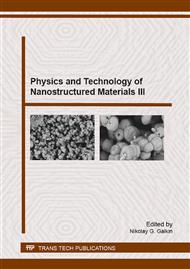p.3
p.8
p.14
p.19
p.23
p.28
p.32
p.42
p.49
Specific Heat of Square Spin Ice in Finite Point Ising-Like Dipoles Model
Abstract:
In the model of finite number (up to 24) of point Ising-like magnetic dipoles with magnetostatic interaction on square 2D lattice within the framework of statistical physics, with using Gibbs formalism and by the means of Metropolis algorithm the heating dependence of temperature has been evaluated. The temperature dependence of the heat capacity on finite number of point dipoles has the finite value of maximum. Together with increase of the system in size the heating peak grows and moves to the area with higher temperature. The obtained results are useful in experimental verification of statistical models, as well as in development and testing of approximate calculation methods of systems with great number of particles.
Info:
Periodical:
Pages:
23-27
Citation:
Online since:
October 2015
Authors:
Price:
Сopyright:
© 2016 Trans Tech Publications Ltd. All Rights Reserved
Share:
Citation:


